 Churches of Christ & Christian Churches in the Pacific Northwest SOUTHERN IDAHO |
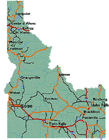 Updated October 8, 2009 by Charles Dailey Main site menu |
Boise |
Caldwell |
Dixie |
Emmett |
Junction |
Meridan |
Midvale
Nampa |
Payette |
Soldier |
Star |
Twin Falls |
Ustick
Washington State |
Pioneer Menu . . .
Search
There were congregations of believers in Southern Idaho before 1879 that had rejected denominational creeds. They were Christians only.At that time, Leonard G. Thompson of Glenwood Springs, Colorado was chosen to be the located preacher. Mr. Thompson was able to work about four months and then resigned because of ill heath. J. H. Holton replaced him in May of 1892. F. M. Walden settled in Boise in 1893 and the membership was 111 that year.Star Mapquest
The earliest services were held at the "Star School-house" to quote the Christian Standard of 1879. The first person immersed into Christ in the Boise Valley was Arabella "Belle" Fulton. She recorded her story in her Tales of the Trail, later released as A Pioneer Woman's Memoir.
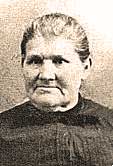
Belle Fulton was the
first believer baptized
in the Boise Valley.
The book is available from the Washington State Library. It can be purchased from Amazon.com.The reader may wish to see a full length article by Jerry Rushford on Mrs. Fulton.
She was converted by Michael Boli (aka Boly or Boley), a preacher from Waitsburg, WA. The little church began with 30 members in January of 1870. She reports the regular preacher as being Doc Callaway.
M. Boli is also discussed in the Reminiscenses of Mac Waller. Kayla Durfee of Athena, Oregon researched the connection between M. Boli and Michael Boly.Star was later a preaching-circuit stop for Daniel W. Fouch and on one Sunday six ladies were immersed into Christ and one man that had been immersed among the Methodists also identified with the local congregation.
Was it David Fouch or was it Daniel Fouch? It seems that both were used to describe the same pioneer preacher. When others wrote of him, it was Daniel. When he signed the report it was David. There is a possibility that the form of his signature was understood as David when it really said Daniel. Is there an expert on script of 100 years ago in the house?
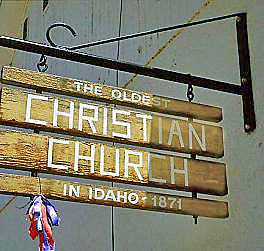
"The Oldest Christian Church in Idaho"
Sign at the Star Christian Church
Daniel and Susan Fouch were overlanders who traveled the Oregon Trail, but stopped their oxen in Boise Valley in 1862. Mrs. Fouch passed from this life while living in Star and her obituary is in the Christian Standard of April 21, 1894.
Later that year Mr. Fouch wrote:
. . . I have lived and preached at Star for twenty-two years. I am old and can't hold the fort much longer. . . . Who will come?There were 60 members at the Star Christian Church in 1888. On the 1911 fire map, the building was located in the S.E. corner of 2nd and River, now called N. Star Road.Midvale Mapquest
Sharing the 1871 founding date is the Midvale Church of Christ, about 10 miles north of Weiser, Idaho. The town was first called Middle Valley, but was changed to Midvale in 1905.
The first preacher for the congregation was Joel M. Jones. (See his extended article below under the Boise entry.) The church met in school houses, then built a building in 1905. Early members included John and Levi Keithly and their families.
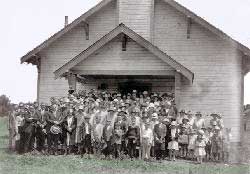
Original Midvale Church
of Christ building
- Courtesy of Midvale Community Library
Richard Boyles from Halfway, Oregon came on a circuit-riding basis in 1895 through 1897. Church membership reached over 100 during those years. C. W. Williams from Illinois settled in Midvale preaching, teaching school and farming.
The congregation is still very active. Its ties are with the a capella Churches of Christ. Our information for this entry came from an article in the 1995 issue of Rocky Mountain Christian by Terry Bonner, minister in 2004. Terry and Kay also operate Eva's Place, a Bed and Breakfast in Midvale.Boise Mapquest
An extended article in the Christian Standard of January, 1879 discusses the advancements of the Lord's cause during the previous year:
Boise Valley, Dec. 7 -- "Since our report from this valley last January, we have had 14 additions to the Church of Christ -- 10 by baptism, 2 from the Methodists, and 2 by relation. Bro. C. J. Wright, a correspondent of the STANDARD, passing through our valley in the month of August, stopped a few days, and preached a few warm and able discourses, and had two additions of the above number. Brother Wright was emigrating from Kansas to the Palouse country, in the northwestern part of this Territory.Mr. Jones' article is rich in content. We learn that he has been working in Churches of Christ in Boise Valley for several years prior to the report. Church planter C. J. Wright moved to the Palouse in 1878. (Mr. Wright then became an ongoing source of information about Washington and Idaho Territories.) New congregations are being formed in the Payette and Weiser areas. A congregation already exists at Star. David Jones speaks very highly of Daniel Fouch."Bro. Fouch and I have recently made a preaching tour to the Payett and Weiser valleys, thirty and fifty miles north of this place, where the gospel in its ancient simplicity has been preached but little. We had 4 additions, and much interest manifested, even by men of the world which they proved by the liberal contributions that they met us with.
"We think the seed that we sowed in those good and honest hearts will be ready for harvest by our return which will be about one month in the future, if the good Master wills.
We are holding a protracted meeting now for the Star congregation, in this valley which we hope will result in much good.
Brother Fouch has been laboring in this country for several years and now we can see some of the fruits of his labors. He is a man of great natural ability, good moral character and influence. He has, can, and no doubt will, do much for the spread and success of the gospel in this lonely West. He greatly deserves, and no doubt will obtain, the rich crown of the good Master that will fade not away." JOEL M. JONES.
We have retained the spelling and punctuation of the original article.
This was 11 years before Idaho became a state. The population of Boise at this time was around 1,000.
By 1887, J. D. Moore wrote in the Christian Standard,
-- Bro. E. W. Barnes has been preaching in Boise City since some time in last winter, beginning with fifteen members. They now number twenty-three.Did the earlier congregation go out of existence? Were these people from the work of Daniel Fouch? The two sentences could be understood either way.By 1891, the church had grown strong enough purchase property and plan a building. W. R. Spindler wrote to the Christian Standard of August 8,
We can safely say that our building is assured. The lot on which it will be located is well situated on what promises to be the finest street in the city, two blocks from the capitol building.The building Spindler referred to was on the west corner of 4th and Jefferson. (Streets sit at an angle.) That was one block from the county courthouse and two blocks from the capitol building. The building was a conventional four window structure with dual entrances. These were frequently used where men sat on one side of the building and women and children on the other. This design was not used after 1900.The church did not have a preacher at the time. As promised, the building was completed and dedicated December 20, 1891 by F. M. Walden of Tacoma, Washington.
W. F. Cowden, who was also present, asserted the date was January 3, 1892.W. F. Cowden wrote:The house is a plain, neat structure, handsomely finished and furnished, costing about $3,000, and seating about 300 persons.He spoke of the debt:This amounted to $1,750, a frightful sum to this little church of only seventeen members. The audience, however, responded promptly and generously, and in a very short time, to the astonishment and joy of all, $1,871.15 was received in cash and pledges. With glad hearts the people joined in a song of and the first beautiful chapel was joyfully and solemnly dedicated to the worship of God. . . .
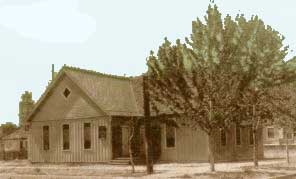
Christian Church Building as it appeared in 1911.
Photo courtesy of Thomas Collins.The first Sunday evening the house would not near seat the people, and many remained standing throughout the services. Forty-eight were added to the church -- 24 by baptism, of whom 13 were men. . . .
Dixie Mapquest
Daniel W. Fouch reported 11 additions to the church in the pages of the Christian Standard in 1879. He was the preacher and was aided by Joel M. Jones.
Soldier Mapquest
Mark Johnson, writing on a web site about Ghost Towns, say:
Soldier was founded in 1881 and, at one time, was the largest community on Camas Prairie. During its heyday it boasted a number of businesses and a large opera house that is still standing today. Soldier's demise began when the Oregon Short Line Railroad bypassed it by 2 miles to the south. As a result, the new town of Fairfield became the "star" of Camas Prairie.The old bank building, opera house and one of the hotels are still standing with the bank and hotel being occupied as residences.
Elder J. D. Moore, writing from Soldier reported in the Christian Standard of 1887:
We are meeting with some success in our work here at Soldier. Last Lord's Day we organized with 10 members; eight of these had been members of the Church of Christ elsewhere, one from the Newlights, and one from the M. E. Church. We hope for other accessions soon.Junction Mapquest
Christian Standard, May 21, 1887. The article was written April 26, 1887.
In order to see Junction on the Yahoo map, it is necessary to click two notches to the right. The town is near Leadore, not at the red star. We have chosen the larger map so viewers can visualize where the community was located. It was on old Highway 28, 3/4 mile west of its junction with Highway 29.
A member of the Christian community, H. Schwartz, wrote a lengthy report and request to the Christian Standard of 1891, asking for a preacher to move to his valley.
. . . . We have no church or Sunday-school organization, but we have some brethren here that are sheep without a shepherd. . . . A few members and myself tried to do something for the Master's cause when we first came out here, by organizing and teaching Sunday-schools. . . . We have had but one Christian preacher during the ten years that I have lived here, and that was W. L. Crim, from Franklin Co., Illinois. He remained with us during the summer of 1885, preached some very interesting sermons, and did much good by preaching the gospel to the people. Now we want a preacher to carry on the good work with was begun by Bro. Crim. . . .Probably no one answered the request for a preacher and the town itself died, its people moving elsewhere.
Caldwell Mapquest
Caldwell was originally known as "Bugtown" when it was a campsite for construction employees of the Oregon Short Line Railroad. Since those years, it has matured into a modern community.
The Christian Church in Caldwell was launched in 1893 according to historian Orval Peterson. However, an article in the Christian Standard of 1892 shows the church was already in existence at least a year earlier. J. A. Holton writes in the July 16th issue:
Visited Caldwell, Idaho, third Lord's Day in June. The brethren have decided to build, and will go to work as soon as a lot is purchased. Brother John C. Rice, one of the elders, writes me that there were two additions there last Lord's Day - one by baptism.An even earlier date can be established from the 1888 Yearbook of the Disciples of Christ. The Caldwell Church is listed with 30 members and Peter Johnson as the contact person.
The church's own records use the later 1892 date:
. . . in March 1892, nineteen pioneers faithful and true gathered to form First Christian Church of Caldwell. During that summer meetings were held in members' homes and in the old Lincoln School building. In November they began holding services at the First Baptist Church on Sunday afternoons. In September 1893 the old athletic hall at 720 Arthur Street was rented and subsequently made suitable for use as a church. That building was purchased for $400 and the indebtedness was paid off June 10,1895.The first church organ was purchased on May 3,1896.
The first State Convention of the Christian Churches of Idaho was held at the Caldwell church in 1898. The congregation quickly outgrew its quarters and property at Kimball and Cleveland was purchased on November 29,1901. The athletic hall building was sold for $400 in August 1902, and the new church was completed June 1,1903. The cost of the new church was higher than expected and when it was finished there was a deficit of $1,000. This was an outstanding church in the city and was the pride of the community and surrounding towns. Following the dedication unsolicited contributions were received from local businessmen and churches and those of neighboring communities with the result the debt was paid off.

The 1903 Caldwell
Christian Church building.
Soon expansion became necessary and two lots adjoining the church were purchased in 1907 on which an annex was built for Sunday School classes, a kitchen and dining room. The church continued to grow, as well as the City of Caldwell, and in the fall of 1908 the board walks around town and around the church were replaced with concrete.
The minister in 1897 was probably C. E. Broxton. In 1902, it was John C. Rice.
The church built at the south corner of Cleveland Blvd. and Kimball Avenue South. (401 Kimball Ave. S.)
Emmett Mapquest
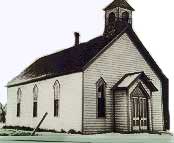
|
in 1906. Courtesy of Emmett Christian Church |
The Emmett Christian Church traces its earliest days to 1894 or 1895. The church first met in rented quarters and even in homes of members. After many uncertainties, they purchased a church building in 1906 and moved it to Third and Washington.
The Sanborn fire map of 1911 shows the building to be at the corner of Third and Hayes and facing Hayes, but the church does not have any record of this.
|
Early members included: Claude Barnes, Dr. N. Barnes, J. F. T. Basye, C. D. Bucknum, Mrs. Sherman Coulter, Mr. and Mrs. Eugene Finn, Dr. Robert H. Greene, D. D. Farnsworth, Edward Heath, E. E. Hunt, Claude Polly, Dr. and Mrs. P. W. Polly, Loe Reed, Mrs. Riggs, Mr. and Mrs. Otto Wilhelm, Mr. and Mrs. J. M. Young |
The first minister was Eugene Finn, followed by G. L. Surber.
A portion of an article from the local newspaper shows a remarkable stewardship.
. . . one orchardist who has been a faithful member of the church for many years promised the fruit from a certain two rows of trees in his apple orchard. There was a bumper crop and excellent prices for apples that year and hence a very substantial donation to the building fund that (came) from this apple grower, as well as various amounts from other members.The church continues today as a strong force for the Lord in the community.
Ustick Mapquest
The launch date of the Ustick Christian Church is uncertain, but it had closed by 1906. Early members included Frank & Ida Swanson and their daughter Luella. We speculate that many of the members migrated to the emerging Meridian Christian Church.
The old township of Ustick derived its name from Dr. H.P. Ustick, a medical doctor who owned a large apple orchard and conceived the idea of the village. The town had a store, post office, bank, realestate office, blacksmith shop, cheese factory and a packinghouse. The town was located N.E. of Meridian, between Meridian and Eagle.
Payette Mapquest
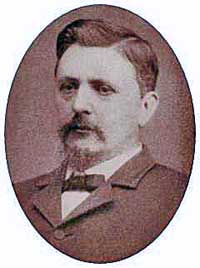
| ||
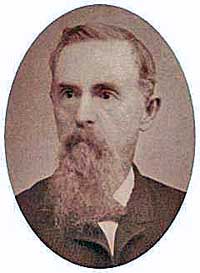
| ||
|
| 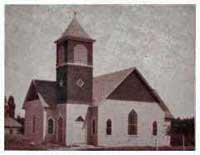
Church in 1900 |
In 1897 George Sloneker decided, along with E. G. Jeffries, to call a "Brother Boils" to conduct a gospel meeting and organize a Church of Christ. We believe this was Richard Boyles of nearby Halfway, Oregon who had been on a preaching circuit for several years.
There were delays, but by April of 1899, the church was organized with the following charter members:
|
Mrs. Hattie L. Ackerman, Marion Ackerman, G. W. Leek, Mrs. Jennie Leek, Mrs. Maude W. Miller, Mrs. Henry Napton, Mary Nell, Stella Nell, Austin Roberts, George Sloneker, George H. Sloneker (father of Clark), Mary Sloneker, Mrs. Nellie C. Sloneker, Dr. Alfred Skippen, Mrs. Sarah Skippen, H. C. Waterman, Mrs. Maggie Waterman, Mrs. J. W. Williams, Mrs. Mamie Whitney, A. E. Wood, Clara Wood and Libbie Wood. |
The church's historian writes, "By May 6, 1899, the little band had increased to 56 charter members. At this time, by vote of the congregation, they decided to organize a Church of Christ after the pattern of the church organized by the Apostles on the day of Pentecost with Christ the Son of God being the only leader."
Green Lee Surber, one of the elders, took the role of minister in 1900. Mr. Surber finished out his years at Payette and is buried by his wife Jennie in the Riverside Cemetery.
For Mr. Surber's obituary, click here.Alexander Wells was the minister in 1904. He, too, lived out his years in Payette and is buried in the Riverside Cemetery. The Payette Independent carried this obituary that we have edited for length:
Thursday, October 08, 1914In 1900 the church built at the southeast corner of Mill (2nd Ave. N.) and Park (N. 9th). This first building was 30 feet by 36 feet with an added annex. Most of the labor was contributed by the members. Even the seating was built by men of the church. By 1904 the mortgage was burned.
DEATH OF ALEXANDER WELLS
Alexander Wells, aged 86, 7 months and 27 days, died at his home in Payette Oct., 2d, 1914. Mr. Wells for the past fifteen years had been one of the most respected and honored citizens of the town. No doubt his life has counted for most in the moral and religious fields. He upheld a high standard of life. Among the worthy principles which he advocated were, the deeper observance of the Lord's Day, temperance, clean speech and pure social relations. He was especially interested in the church, for him the Kingdom of God was a matter of supreme importance. As a member of the Church of Christ in this place he was regular in attendance, loyal in its support and conspicuities in its service.He held the position of Elder for many years during which time he carefully endeavored to discharge such duties as were his. Often he has admonished the erring in that kind Christian Spirit which characterizes a true shepherd of the Lord. He adored no compromise with the world and worldly things but prayed and worked that the Church should be without spot and without blemish. At times he has sacrificed his own personal interests for the good of Church. He was well versed in the Sacred Scriptures and frequently in the absence of his pastor he filled the pulpit with edification and profit to all. His mind was remarkably clear, even in his last year he discussed accurately the problems of life and religion. He had a rare sense of clean wholesome wit and humor. His presence at any social gathering was a sure indication of good cheer. His after-dinner talks were always enjoyable. His cheerfulness and hopefulness together with his splendid habit of life account in part for his long life. His moral influence will be missed in the community, his spiritual strength will be miss in the church and his genial presence will be missed most in the home.
http://payettecounty.info/riverside/riverobitsw/wellsalexander.htmlFor Mr. Well's obituary, click here.
Twin Falls Mapquest
The city of Twin Falls was platted in 1904 and in July of that year a Sunday School began. Several local denominations trace their origins to that effort including the First Christian Church.
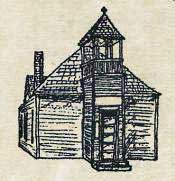
|
Twin Falls Christian Church building. |
The church began as prayer meetings held in homes. Leaders included Mr. and Mrs. E. T. Pate, C. D. Thomas and W. D. Brunk. Soon preacher Leroy Stephens settled in the new town to bring together the group and construct a building. Mr. Stephens and his wife lived in a floored tent on Main Street.
While the building was under construction, services were held in a school house. By October, the building had its siding on the walls and sheeting on the rafters. A dust storm arose that severely damaged the building, but it was repaired and the work continued. By November of 1905, the building was dedicated with forty-eight charter members. This building was on Third Avenue E.
The church quickly outgrew its starting building and built again on the east corner of 4th Avenue E. and 2nd Street E. An historian of the congregation writes:
It could be said that the permanent work of the church began with the dedication of the Fourth Avenue Building. Before that event the congregation had been going through a sort of camping-out period. Hitherto its ministry had been irregular—pastors arriving and departing almost without warning, and often employed on a temporary basis; the services held part of the time in a church building too small for the work, part of the time in a lodge hall while a revival was held in a warehouse with a dirt floor and in the livery stable and junk yard section of the city.This second building was dedicated in 1910. It, in turn, was replaced by a more spacious building in 1929.
Nampa Mapquest
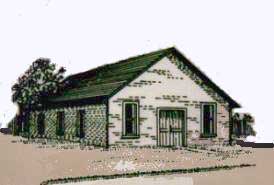
|
Nampa Christian Church building. |
The Christian Church had its origins here in February of 1906. It celebrated 75 years in 1981. That year it had a commemorative dinner plate made and it is from that plate we were able to get the photo that accompanies this article.
The building was shoehorned onto the property at 13th Avenue S. and 4th S. (323 13th Ave. S.) Soon a brick building, the Colonial Apartments, was built next door.
Meridian Mapquest

|
Early members included Solomon and Sarah Lee, William and Viola Yost, John Waugh and Raymond L. Floyd.
The building was located near the intersection of E. State Avenue and North Meridian Road. It shows on the fire map of 1912. The congregation has evolved through the century into the present day Ten Mile Christian Church.
Montana State . . . Pioneer Menu
To DOCHS 3/03
